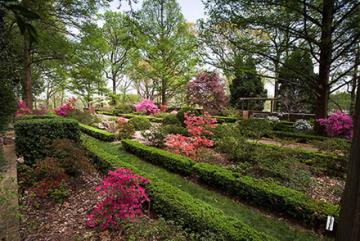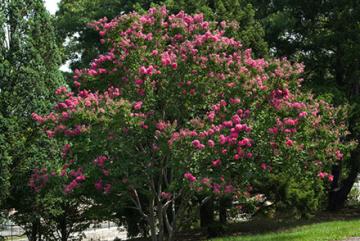The U.S. National Arboretum: Where Science Meets Beauty

Important to the nursery/landscaping industry, green boxwood shrubs are shown in traditional hedges interspersed with azaleas at the U.S. National Arboretum in Washington, DC. (Stephen Ausmus, D925-1)
Now is a good time to take a virtual trip to the U.S. National Arboretum (USNA). If you have ever visited the Arboretum, you know it’s truly where science meets beauty.
Established in 1927, the Arboretum, located in Washington, DC, is administered by USDA’s Agricultural Research Service (ARS). The Arboretum is a leading scientific institution where you’ll find an oasis of plants, gardens, and unique collections all in a natural setting. Through programs, exhibits, demonstrations, and more, USNA inspires discovery, understanding, conservation, application of plant science, and our dependence on plants. The Arboretum exists to educate the public about plants, help scientists understand them, enhance plant varieties, and further science.
A public garden with over 400 acres, of gardens, woodlands, and meadows, the Arboretum has about 9 miles of roadway. Within the gardens and collections is an important plant genetic resource used for a variety of scientific endeavors. Scientists here focus on resolving problems with diseased landscape plants. They use the plant genetic resource to identity plants that are resistant to disease and then breed them. Crape myrtles bred to have resistance to powdery mildew are successful examples of this process.
Many of the plants and flowers that we have in our homes and gardens can be attributed to the work of the Arboretum. Through their plant research, breeding, and selection to develop new cultivars, we now have plant varieties with enhanced characteristics, such as bloom color, attractive growth habit, hardiness, and the ability to resist drought. Keeping critical plant data, tracking their source and scientific names, and maintaining regular inventory are all vital to sustaining the integrity of the collections.
According to ARS research horticulturalist Scott Aker, whether its weed control, pest control, or watering, everything that people do in their own gardens is magnified a thousand-fold at the Arboretum.
There is plenty to experience at the Arboretum. Though beautiful and informative, it can also be challenging since the Arboretum covers a vast area. To assist with navigating around the grounds, USNA staff created a free app that provides maps and directions and delivers real-time information on the different exhibits as well as upcoming events.
Whatever the season, there is always something to see at the Arboretum.
Fall
Fall in love with the tree leaves as they transition from summer green to red, yellow, and orange, or gaze at the tulip poplar and dogwood; meadows sport carpets of golden wildflower blossoms.
Winter
Capture a glimpse of snow and ice as it transforms the gardens into a beautiful jeweled landscape and the 'Sparkleberry' hollies (developed by scientists at the USNA) sparkle with dazzling red berries.
Spring
Experience the woodland wildflowers, saucer magnolia blossoms, miniature daffodils, and the fragrant and popular cherry blossoms.
Summer
Admire the daylilies and crape myrtles with their robust summer blooms.
Visit the USNA website to learn more about hours of operation, visitor services, collections, and more.—By Monica Williams, ARS Office of Communications.



